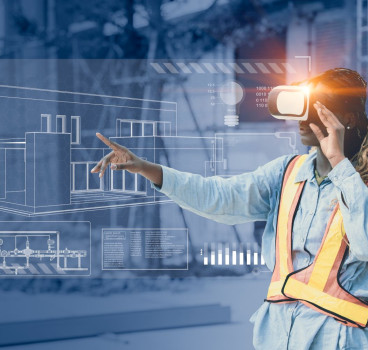What will be the ethics of AI in construction?
The integration of Artificial Intelligence (AI) into the construction industry promises much. From AI-driven scheduling and predictive analytics for material procurement to automated quality control and robotic construction, the digital revolution is reshaping traditional workflows. However, this technological advancement is not without many ethical implications. As these advanced systems assume greater autonomy in decision-making, critical challenges will emerge concerning algorithmic bias, the societal impact of job displacement and the establishment of clear lines of accountability for AI-driven errors, writes John Ridgeway.
The particular issue of algorithmic bias represents a fundamental ethical challenge within AI integration. AI systems learn and operate based on the data they are trained on. If this historical data reflects existing human biases, whether intentional or unintentional, the AI will perpetuate and potentially amplify those biases.
In construction, this can manifest in several critical areas. Consider AI-powered scheduling algorithms, as an example. If historical project data used for training disproportionately reflects projects managed by specific demographics, or relies on timelines that inadvertently penalise certain subcontractors, the AI might inadvertently generate schedules that disadvantage particular teams or exacerbate existing inequities in workload distribution.
Similarly, AI used for material selection or supplier recommendations, if trained on data reflecting historical preferences or performance metrics that are incomplete or skewed, could inadvertently favour certain suppliers, potentially limiting market access for smaller or newer companies.
The ramifications extend to risk assessment and safety protocols. An AI trained on historical accident data might, for instance, identify patterns of risk that correlate with demographic factors or specific work methods which were themselves influenced by historical biases, leading to disproportionate scrutiny or even discriminatory allocation of safety resources.
The lack of transparency in many complex AI models, often referred to as their 'black box' nature, exacerbates this problem. Without the ability to fully interrogate the decision-making process of an algorithm, identifying and rectifying embedded biases becomes exceedingly difficult, raising questions of fairness, equity and due process within project execution. Ensuring that AI systems are trained on diverse, representative and rigorously vetted datasets, coupled with continuous auditing for discriminatory outputs, is paramount to mitigating this inherent risk.
Direct questions
The integration of AI and automation also poses direct questions regarding job displacement. Historically, technological advancements have always reshaped labour markets, creating new roles while rendering others obsolete. AI in construction is no exception. Automated machinery, AI-driven project management tools and robotics performing tasks like bricklaying, welding, or repetitive quality inspections have the potential to significantly reduce the demand for manual labour in specific trades. While this may lead to increased efficiency and address persistent shortages in some areas, the societal impact on the existing workforce cannot be ignored.
The ethical dilemma here lies in how the industry manages this transition. A purely efficiency-driven approach, without regard for the human element, risks creating significant social disruption, unemployment and widening skills gaps. Responsible AI integration demands a proactive strategy that prioritises reskilling and upskilling programmes for the existing workforce.
This involves identifying which roles are most susceptible to automation and developing targeted training initiatives to transition workers into new, often more digitally-focused, positions that emerge alongside AI adoption, such as roles in AI supervision, data analysis, robotics maintenance, or human-AI collaboration. The ethical imperative is to ensure a just transition, where the benefits of technological progress are broadly shared and workers are not simply displaced but empowered to adapt and thrive in the evolving construction landscape. This requires collaboration between industry, educational institutions and policy makers to invest in human capital development, ensuring that the workforce is prepared for the jobs of tomorrow, not just the operations of today.
Perhaps the most complex ethical challenge in an AI-integrated construction environment revolves around accountability in automated decision-making. When an AI algorithm recommends a critical structural change, or a robotic system executes a task resulting in error or failure, who bears ultimate responsibility? In traditional construction, the lines of accountability are relatively clear - the architect for design flaws, the engineer for structural miscalculations, the contractor for faulty execution, or the site manager for operational oversight. However, AI introduces a new layer of complexity, blurring these established boundaries.

If an AI-driven scheduling system, designed to optimise resource allocation, inadvertently creates a safety hazard by over-compressing a critical path, is the fault with the AI developer, the project manager who approved the AI's recommendation, or the algorithm itself? If an AI-powered quality control system fails to detect a material defect that subsequently leads to structural compromise, where does accountability reside? The current legal and ethical frameworks were not designed for scenarios where autonomous or semi-autonomous systems make decisions with real-world consequences.
Real world consequences
Establishing clear lines of accountability requires multifaceted solutions. Firstly, there is a need for transparent AI design and deployment. Developers must provide clear documentation of an AI's operational parameters, its limitations and the data it was trained on.
Secondly, human oversight and intervention remain crucial. AI should be viewed as an augmentative tool, not a replacement for human judgment, particularly in high-stakes decisions. Project managers and engineers must retain ultimate responsibility for approving AI recommendations, understanding the rationale behind them and overriding them when necessary, based on their expertise and ethical judgment.
Thirdly, contractual clarity is essential. Contracts between clients, contractors, AI developers, and technology providers must explicitly define the allocation of risk and liability for AI-related errors. This may necessitate new forms of insurance or liability models that account for the unique characteristics of AI-driven systems. Finally, ongoing regulatory development will be necessary to establish legal precedents and frameworks that address AI accountability in a fair and just manner, balancing innovation with public safety and professional responsibility.
The ethical considerations extend beyond these primary areas. The security and privacy of data collected by AI systems on construction sites is another significant concern. Drones, sensors, and cameras gather vast amounts of information, including potentially sensitive data about workers (e.g., location tracking, performance metrics) or proprietary project details. Ensuring robust cybersecurity measures, obtaining informed consent for data collection, and establishing clear data governance policies are essential to prevent misuse, breaches, or unauthorised access to this information. The 'right to be forgotten' and data anonymisation practices become increasingly relevant in this context.
Furthermore, the potential for deskilling some roles, where reliance on AI leads to a diminished human capacity for fundamental tasks, represents a long-term ethical concern. While AI can handle routine calculations or complex simulations, a generation of engineers who only interact with black-box AI tools might lose the intuitive understanding and problem-solving skills that were once honed through manual processes. Balancing the efficiency gains of AI with the imperative to maintain and enhance human expertise through continuous training and critical engagement with the technology is vital for the long-term health of the profession.
Finally, the ethical implications of AI's influence on industry standards and innovation must be considered. If AI systems become the de facto standard for design optimisation or material performance prediction, there's a risk of stifling unconventional approaches or emergent materials that fall outside the parameters of the AI's training data. Ensuring that AI remains a tool for innovation, rather than a force for conformity, requires intentional design that encourages exploration and critical human oversight in the adoption of AI-generated solutions. The industry must foster an environment where novel ideas, even if not immediately recognised by an AI, can still be explored and validated by human ingenuity.
All this means that the future of construction, powered by AI, depends not just on what we can build, but on how we ethically choose to build, ensuring that innovation serves the broader interests of society, fosters equity and maintains the integrity of human expertise and accountability within this vital sector.
Additional Blogs

Are architects losing their influence in the digital era?
For decades, architects have been the central creative force in construction, shaping the buildings we see and the way projects are conceived, communicated and delivered. Their role has been...
Read moreWhy the word “Innovation” has lost its meaning in construction
“Innovation” has become one of the most overused terms in construction. It appears in the dozens of press releases we receive each day, conference talks and project reports, often without any real...
Read more

Retrofit fatigue and are we asking too much of old buildings?
As the world pushes toward net-zero emissions, the pressure to decarbonise our built environment is more intense than ever. Governments, developers and building owners are investing heavily in energy...
Read more